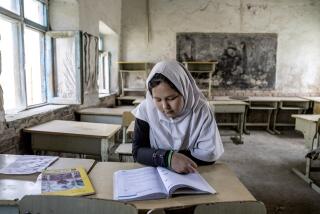The Lure of Schooling Draws a Crowd
- Share via
JALALABAD, Afghanistan — They rose with the sun, scrubbed their cheeks and picked their way over pebbly paths to the schoolyard. Word spread fast in the neighborhood, and, by the time the sun grew hot, 200 girls were clustered in the yard, pushing and giggling.
Monday was the first day at the Naswan Girls School, a dilapidated group of classrooms shut down by Taliban troops four years ago. The pupils came with empty hands, and they weren’t sure what was supposed to happen next. Some of them had never seen the inside of a classroom.
“Today I am very happy,” said Bibi Zanan, a 9-year-old in black veils. “Usually there is nothing to do but help my mother haul water, and learn to cook. I want to learn English.”
Soon after, a man with a long white beard swept in off the street and mounted a cement ledge.
“Welcome to your school,” boomed Malam Abdul Ghani, who was hastily named director of education for this area last week. “We are the new government, and we will pay your teachers’ salaries. Don’t worry about anything. You’ll have no problems here.”
The girls squinted at him, listening to the shaky promise of a fledgling government. These are times of battles and shifting politics, when bombing raids rattle the children awake at night. It’s impossible to tell whether Ghani will be able to keep his word--and if so, whether the schools will endure long enough to do these girls much good.
But in Afghanistan, land of perpetual warfare, home to a generation of children who learned to fight instead of read, this was a breath of normality.
“After all these years, we are in a bad condition,” said a 42-year-old teacher named Brisa. “But we also have two hands and two feet, and we can work. It is our duty to overcome these hardships.”
Monday’s beginning was somewhat inauspicious. It didn’t take long for the teachers to realize that things weren’t ready. The pupils were eager--but the school had no chairs, desks, books, chalk, paper or pens.
So the girls were sent home with instructions to check back later this week. They filed away, and the schoolyard fell quiet. In a dusty storage room, the teachers stared glumly at a jumble of busted and chipped tables.
It was 1997 when Taliban soldiers swept into Jalalabad, ordered women to stay home and took over the school building. In time, the regime decided to set up an Islamic theological school in the abandoned classrooms. The resulting madrasa was, of course, only for men. Monday, an abandoned Taliban jeep sat rusting on the playing field.
Under Taliban law, girls were banned from obtaining an education, and their female teachers were forbidden to work.
“I used to feel like a bird. I used to feel free,” Brisa said. “Then the Taliban came and put me in a cage, and I have lived these years in my house.”
Today, there’s not much foundation at the school upon which to build. Naswan is a barren ring of cement classrooms. The vacant rooms are dusty and drafty. The roof has holes, walls are missing, and sheets of plastic tarp stand in for broken windows.
The physical neglect is mirrored in the children’s educational background. Many of the girls can’t read, even some of the teens. And many are unlikely to be around for long. In the years since their school shut down, they have seen their elder sisters grow up, marry and have babies. Their male counterparts have taken up machine guns and headed for the hills.
“Their lives are destroyed,” schoolteacher Nargis Sediqi said.
In fact, the disappearance of girls schools here began years before the Taliban. Radical tribal soldiers who controlled the city during the mid-1990s first cracked down on women’s schooling.
Today, as conflict rages throughout Afghanistan, Jalalabad has fallen back into the hands of tribal warlords. Trailed by squads of anti-Taliban guerrillas, self-appointed commanders chased the Taliban out of town almost two weeks ago and grabbed the cars, buildings and neighborhoods they left behind.
The new municipal government then embarked on a flurry of politicking: Ministers were appointed, rules were invented and revised--and the advent of public coeducational schooling was announced.
Silent in their creased burkas, the teachers hung back Monday morning and eyed their squealing pupils. Nobody had explained to them how much they would be paid or where the money would come from.
“We don’t trust these leaders,” Sediqi murmured, pulling her veil over her mouth as she spoke. “We remember what they did before, and we don’t think the future will be good.”
More to Read
Sign up for Essential California
The most important California stories and recommendations in your inbox every morning.
You may occasionally receive promotional content from the Los Angeles Times.













